Resources
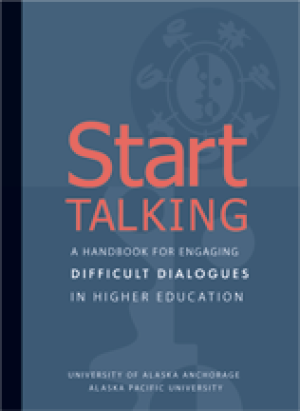
Click Here for Book Review The University of Alaska Anchorage and Alaska Pacific University created Start Talking: A Handbook for Engaging Difficult Dialogues in Higher Education, a field manual for professors who wish to engage their students more effectively in conversations about the most important issues of our time. The book addresses themes of academic freedom; classroom safety; rhetoric and debate; race, class and culture; science and religion; and business, politics and social justice. For information about the project, including faculty intensives on difficult dialogues and indigenous ways of teaching and learning, see UAA Initiatives. (From the Publisher)
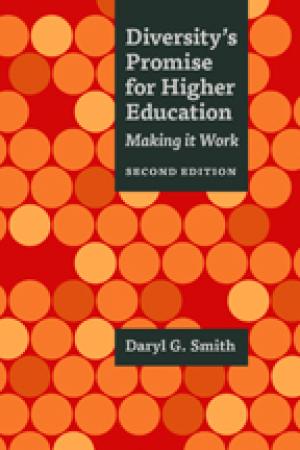
Daryl G. Smith has devoted her career to studying and fostering diversity in higher education. She has witnessed and encouraged the evolution of diversity from an issue addressed sporadically on college campuses to a reality of the modern university experience. In Diversity’s Promise for Higher Education, Smith brings together scholarly and field research relevant to the next generation of diversity work. The book argues that achieving excellence in a diverse society requires increasing the institutional capacity for diversity while simultaneously working to understand how diversity is tied to better leadership, positive change, research in virtually every field, student success, accountability, and more equitable hiring practices. To become more relevant to society, the nation, and the world while remaining true to their core missions, colleges and universities must continue to see diversity—like technology—as central, not parallel, to their work. In Diversity’s Promise for Higher Education, Smith proposes a set of clear and realistic practices that will help colleges and universities locate diversity as a strategic imperative and pursue diversity efforts that are inclusive of the varied—and growing—issues apparent on campuses without losing focus on the critical unfinished business of the past. In this edition, which is aimed at administrators, faculty, researchers, and students of higher education, Smith emphasizes a transdisciplinary approach to the topic of diversity, drawing on an updated list of sources from a wealth of literatures and fields. The tables have been refreshed to include data on faculty diversity over a twenty-year period and the book includes new information about gender identity, stereotype threat, student success, the growing role of chief diversity officers, the international emergence of diversity issues, faculty hiring, and implicit bias. (From the Publisher)
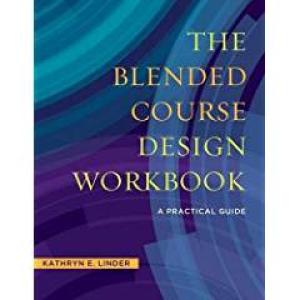
Click Here for Book Review Blended (also called hybrid) classrooms, in which face-to-face interaction is intentionally combined with online activities to aid student learning, are becoming more and more common. Most recently, “flipped” classrooms have become a popular method for teaching because more time for active learning in-class can be gained by moving content delivery such as lecture to outside-of-class homework using technology tools such as video or lecture capture. The blended model is proving to be an environment that provides more self-directed, technology-mediated learning experiences for students who will be incorporating technology more and more into their professional lives post-college. The Blended Course Design Workbook meets the need for a user-friendly resource that provides faculty members and administrators with instructions, activities, tools, templates, and deadlines to guide them through the process of revising their traditional face-to-face course into a blended format. Providing a step-by-step course design process that emphasizes active learning and student engagement, this book will help instructors adapt traditional face-to-face courses to a blended environment by guiding them through the development of course goals and learning objectives, assignments, assessments, and student support mechanisms with technology integration in mind. It will also help instructors choose the right technologies based on an instructor’s comfort level with technology and their specific pedagogical needs. The book will help each instructor who uses the text to develop a unique course by making choices about their course design based on student learning needs for their chosen topic and discipline. Every component of the workbook has been piloted with faculty designing and implementing blended courses and then revised to better meet the needs of faculty across a range of comfort levels with technology use. The Blended Course Design Workbook includes detailed instructions for each stage of course design alongside specific activities that the reader can complete. The book is unique because it facilitates a step-by-step process for blended course design with specific templates and tools that can be used across disciplines. (From the Publisher)
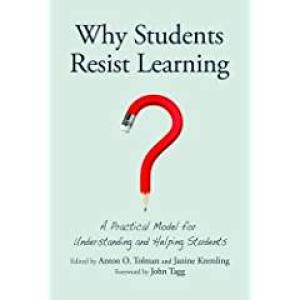
Click Here for Book Review However personally committed faculty may be to helping students learn, their students are not always as eager to participate in this endeavor, and may react with both active and passive resistant behaviors, including poor faculty evaluations. The purpose of this book is to help faculty develop a coherent and integrated understanding of the various causes of student resistance to learning, providing them with a rationale for responding constructively, and enabling them to create conditions conducive to implementing effective learning strategies. In this book readers will discover an innovative integrated model that accounts for student behaviors and creates a foundation for intentional and informed discussion, evaluation, and the development of effective counter strategies. The model takes into account institutional context, environmental forces, students’ prior negative classroom experiences, their cognitive development, readiness to change, and metacognition. The various chapters take the reader through the model’s elements, exploring their practical implications for teaching, whether relating to course design, assessments, assignments, or interactions with students. The book includes a chapter written entirely by students, offering their insights into the causes of resistance, and their reflections on how participating on this project has affected them. While of great value for faculty, this book is also useful to faculty developers advising future and current faculty, as well as to administrators, offering insight into how institutional values impact teaching practice and student attitudes. (From the Publisher)

Click Here for Book Review Abstract: Preparing a learning portfolio has become a mandatory part of the course work in most clinical professions. Students and educators alike sometimes complain that these mandatory assignments become repetitive and uninspired. However, we all need to be able to speak and write clearly as we work with our colleagues, students and those we care for. In Portfolio To Go, Allan D. Peterkin insists that reflective capacity, critical thinking, creative expression, and narrative competence are attributes that should be developed in every health professional – regardless of the discipline or specialty. Trainees will find over 1000 prompts organized under themes highly relevant to students and educators, including those not formally addressed in class, such as coping with uncertainty and ambiguity, team conflict, and resilience through good self-care. Practical tips for writing effectively and for discussing and evaluating narratives in a helpful, respective manner are provided throughout. Peterkin is a pioneer in emphasizing patient-centred, humanistic care and Portfolio To Go will help to train and develop more reflective practitioners. (From the Publisher)
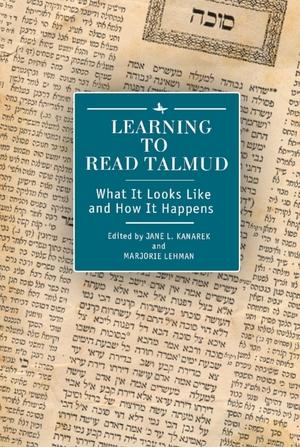
Click Here for Book Review Learning to Read Talmud is the first book-length study of how teachers teach and how students learn to read Talmud. Through a series of studies conducted by scholars of Talmud in classrooms that range from seminaries to secular universities and with students from novice to advanced, this book elucidates a broad range of ideas about what it means to learn to read Talmud and tools for how to achieve that goal. Bridging the study of Talmud and the study of pedagogy, this book is an essential resource for scholars, curriculum writers, and classroom teachers of Talmud. (From the Publisher)

The past thirty years have witnessed tremendous societal and ecclesial changes that continue to inform ministry education in the 21st century. In Seminary Formation, Katarina Schuth, OSF, examines the many aspects of theologate-level schools including their structures and missions, organization and leadership, student enrollment, backgrounds of both seminarians and lay students, and the evolution and development of degree programs, including human and spiritual, intellectual and pastoral formation. Seminary Formation also helpfully includes substantial commentaries on Schuth's research by Ronald Rolheiser, Thomas Walters, Leon M. Hutton, Barbara Reid, and Peter Vaccari. An exploration of the changes in seminaries and schools of theology, with statistical analysis, from 1985 to the present, Seminary Formation anticipates the challenges ahead and considers new directions for the future. (From the Publisher)
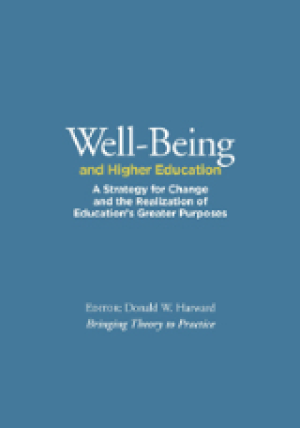
Click Here for Book Review The newest release from Bringing Theory to Practice, Well-Being and Higher Education, explores the multiple connections of well-being to higher education and why those connections matter—for the individual lives of students and those who teach; for the institution; and for whether or not the unique promise of higher education to a democratic society can be advanced and realized. The publication’s thirty-five original essays and provocations—by some of the most highly respected voices within and beyond the academy—address the theoretical underpinnings and practical expressions of these connections. Articles include “Higher Education, the Struggle for Democracy, and the Possibility of Classroom Grace”; “Why Well-Being is Fundamental to Liberal Learning”; “Honoring the Humanity of Our Students”; “Thriving: Expanding the Goal of Higher Education”; and “College Makes Me Feel Dangerous: On Well-Being and Nontraditional Students.” Well-Being and Higher Education opens the discussion on learning’s connection to well-being; responds to current challenges against the state of higher education today; and brings to the forefront a conversation considering the greater purposes of higher education and the need to preserve and revive the institution’s role to look beyond itself to a greater good. (From the Publisher)

Click Here for Book Review The higher education landscape is rapidly evolving due to changes in the student population (millenials, increasing diversity, changing work habits), technology (the rise in the use of social media) and learning spaces (the increase in physical and virtual social learning spaces). Allan presents the first book to bring together recent developments in both theory and practice, covering a wide range of tools and techniques which will suit students in different contexts, from large groups of 500+ to very small classes of research students. Making extensive use of case studies, examples, checklists, and tables, this practical book contains: - an analysis of the current higher education landscape, the changes that are occurring and the diverse nature of student populations; - an exploration of new theories of digital literacy including case studies demonstrating how library and information workers have applied these models in practice; - a demonstration of the many different ways in which academic library and information services are working in support of student employability; - a theoretical overview of different approaches to teaching and learning including Kolb's learning cycle, Laurillard's conversational framework for university teaching, Entwistle's teaching for understanding at university, Land and Meyer's threshold concepts and the Higher Education Academy's work on flexible pedagogies; - practical guidance on designing, developing and evaluating courses and other learning and teaching events in different situations including face-to-face, flipped classroom, blended learning, and online learning; and an exploration of approaches to personal and professional development including 90+ approaches to workplace learning; accredited courses; short courses, conferences and workshops; - networking through professional organizations; and developing online networks. This book will be essential reading for different groups working in colleges and universities including library and information workers, staff developers, educational technologists, educational development project workers, educational change agents and students of library and information science who are planning their careers in higher education institutions. (From the Publisher)
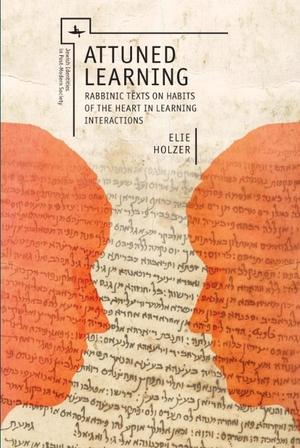
Click Here for Book Review Practice-oriented educational philosopher Elie Holzer invites readers to grow as teachers, students, or co-learners through “attuned learning,” a new paradigm of mindfulness. Groundbreaking interpretations of classical rabbinic texts sharpen attention to our own mental, emotional, and physical workings as well as awareness of others within the complexities of learning interactions. Holzer integrates pedagogical pathways with ethical elements of transformative teaching and learning, the repair of educational disruptions, the role of the human visage, and the dynamics of argumentative and collaborative learning. Literary analyses reveal that deliberate self-cultivation not only leads to ethical and spiritual growth, but also offers a corrective for the pitfalls of the contemporary calculative modalities in educational thinking. The author speaks to the existential, humanizing art of learning and of teaching. This book can serve as a companion volume for A Philosophy of Havruta: Understanding and Teaching the Art of Text Study in Pairs, adding a new dimension of its model of joint learning. (From the Publisher)